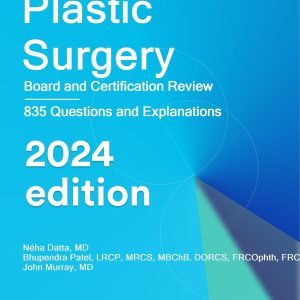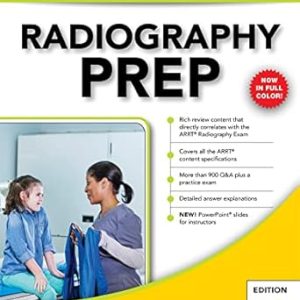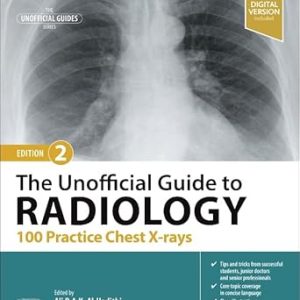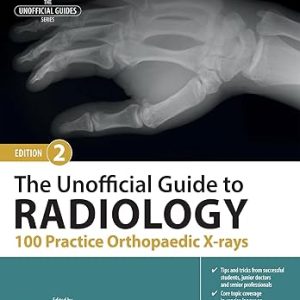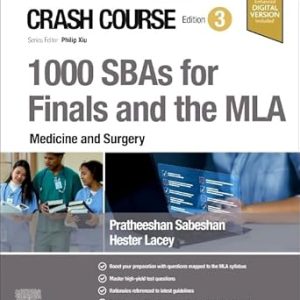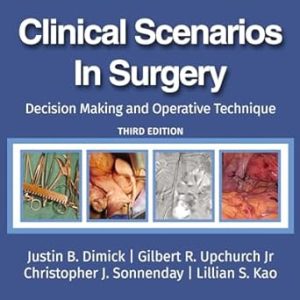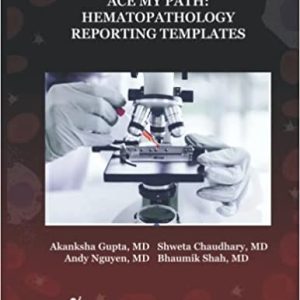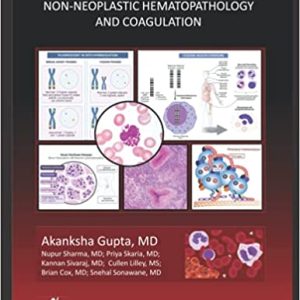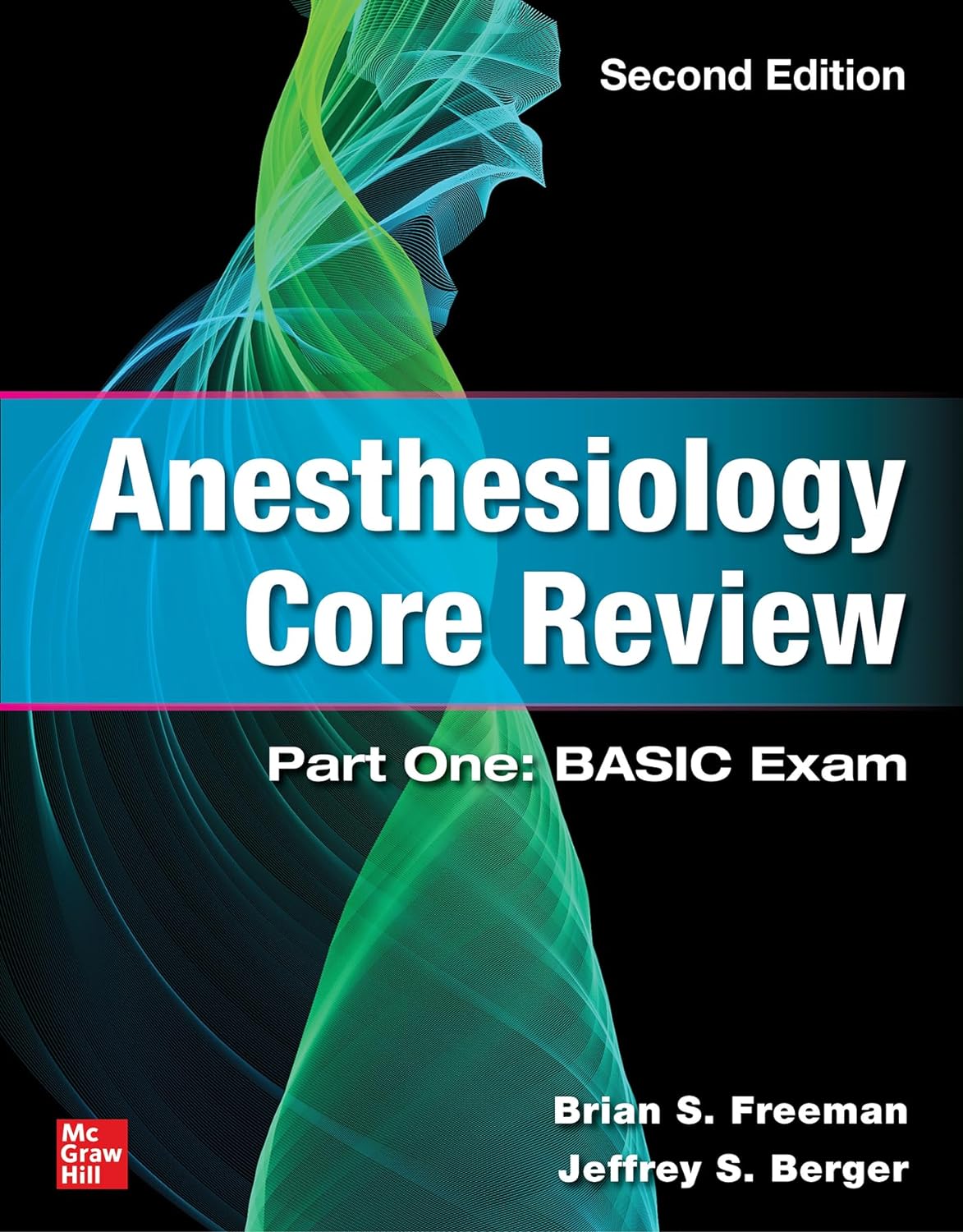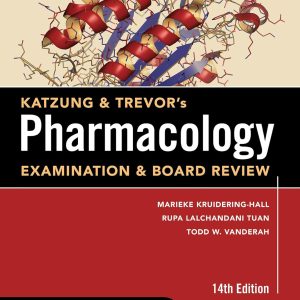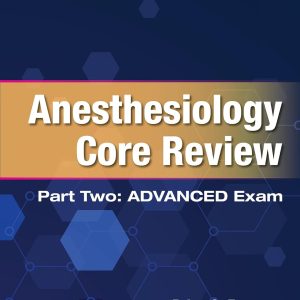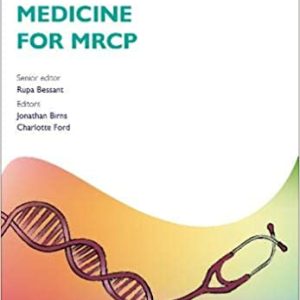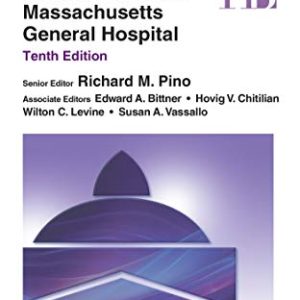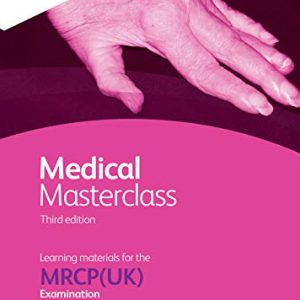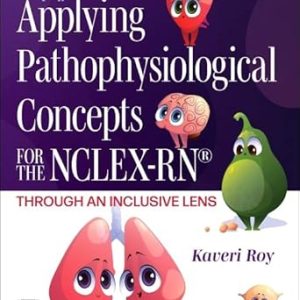by Brian Freeman (Author), Jeffrey Berger (Author) is the essential, high-yield review for Part One of the ABA BASIC Exam―updated to align with the latest exam blueprint.
Anesthesiology residents must pass the BASIC exam in order to continue their training. This essential resource is the single best way to take the stress out of this make-or-break exam, focus your study on nearly 200 must-know topics found on the board exam outline, and identify your areas of strength and weakness. Written by program directors with many years of board examination advising experience, Anesthesiology Core Review: Part One: BASIC Exam succinctly summarizes key concepts in basic science and clinical anesthesia practice. Space is conveniently provided throughout the book to add notes from other study resources. This updated second edition reflects the latest literature and incorporates new topics such as COVID-19.Contents
Contributors to the First Edition xi
Contributors to the Second Edition xiii
Preface xv
PART I BASIC SCIENCES 1
1. Topographical and Clinical Anatomy 3
2. Radiological and Ultrasound Anatomy 19
3. Mechanics 27
4. Flow and Velocity 29
5. Principles of Doppler Ultrasound 33
6. Properties of Gases and Liquids 35
7. Gas Laws 37
8. Vaporizers 39
9. Uptake and Distribution of Inhalational Agents 43
10. Concentration and Second Gas Effects 47
11. Nitrous Oxide and Closed Spaces 49
12. Anesthesia Breathing System: Components 51
13. Anesthesia Breathing System:
Safety Features 53
14. Anesthesia Breathing System:
Physical Principles 55
15. Circle and Noncircle Systems 57
16. Portable Ventilation Devices 61
17. Absorption of Carbon Dioxide 63
18. Oxygen Supply Systems 67
19. Waste Gas Evacuation Systems 69
20. Monitoring Neuromuscular Function 71
21. Monitoring Mechanical Ventilation 75
22. Monitoring Temperature 79
23. Oximetry 81
24. Measuring Blood Gases 83
25. Gas Concentrations: Monitoring and
Instrumentation 87
26. Pressure Transducers 91
27. Noninvasive Blood Pressure Measurement 93
28. Neurologic Function Monitors 95
29. Autotransfusion Devices 99
30. Body Warming Devices 101
31. Mechanical Ventilation: Principles of Action 103
32. Mechanical Ventilation: Modes 107
33. Mechanical Ventilation: Monitors 111
34. Noninvasive Mechanical Ventilation 115
35. Operating Room Alarms and Safety Features 119
36. Defibrillators 123
37. Electrical Safety 127
38. Review of Simple Mathematics 129
39. Statistics 133
40. Computerized Patient Records 137
41. Pharmacokinetics 139
42. Pharmacokinetics of Neuraxial Drug
Administration 143
43. Drug Tolerance and Tachyphylaxis 145
44. Drug Termination of Action 147
45. Drug Interactions 149
46. Drug Reactions 153
47. Alternative and Herbal Medications 155
48. Anesthetic Gases: Principles 157
49. Anesthetic Gases: Organ System Effects 161
50. Minimum Alveolar Concentration 163
51. Opioids 167
52. Barbiturates 171
53. Propofol 173
54. Etomidate 177
55. Benzodiazepines 179
56. Ketamine 181
57. Dexmedetomidine 183
58. Local Anesthetics 185
59. Local Anesthetic Toxicity 191
60. Muscle Relaxants 195
61. Antagonism of Neuromuscular Blockade 199
PART II CLINICAL SCIENCES 201
62. Physical Examination and Airway Evaluation 203
63. ASA Preoperative Laboratory Testing
Guidelines 207
64. ACC/AHA Guidelines for Perioperative
Cardiovascular Evaluation 209
65. ASA Physical Status Classification 213
66. Premedication 215
67. “Full Stomach” Status 217
68. Management of Chronic Medical Therapy 221
69. Prophylactic Cardiac Risk Reduction 225
70. Prophylactic Antibiotics 227
71. Spinal Anesthesia 231
72. Epidural Anesthesia 235
73. Combined Spinal–Epidural Anesthesia 239
74. Caudal Anesthesia 241
75. Epidural Test Dose 243
76. Complications of Neuraxial Anesthesia 247
77. Neuraxial Anesthesia: Physiologic Effects 251
78. American Society of Regional Anesthesia and
PainMedicine (ASRA) Guidelines: Neuraxial
Anesthesia and Anticoagulation 253
79. Intravenous Regional Anesthesia 257
80. Transversus Abdominis Plane Blocks 259
81. Stages and Signs of General Anesthesia 263
82. Awareness Under General Anesthesia 265
83. Techniques of General Anesthesia 267
84. Assessment and Identification of the
Difficult Airway 271
85. Approaches to Difficult Airway Management 273
86. The ASA Difficult Airway Algorithm 275
87. Intubation Devices 279
88. Alternative Airway Devices and Adjuncts 283
89. Transcutaneous and Surgical Airways 287
90. Endobronchial Intubation 289
91. Intubation and Tube Exchange Adjuncts 291
92. Types of Endotracheal Tubes 293
93. ASA Monitoring Standards 295
94. Monitored Anesthesia Care and Sedation 297
95. ASA Sedation Guidelines for
Non-Anesthesiologists 301
96. Intravenous Fluid Therapy 305
97. Crystalloids versus Colloids 309
98. Epistaxis 311
99. Corneal Abrasions 313
100. Postoperative Visual Loss 315
101. Air Embolism 317
102. Intraarterial Injections 321
103. Pressure Injuries 323
104. Iatrogenic Burns 325
105. Chronic Environmental Exposure to
Inhalation Agents 329
106. Hypothermia 331
107. Nonmalignant Hyperthermia 335
108. Bronchospasm 337
109. Anaphylaxis 341
110. Laryngospasm 343
111. Postobstructive Pulmonary Edema 347
112. Aspiration of Gastric Contents 349
113. Malignant Hyperthermia 355
114. Postoperative Pain Relief: Pharmacologic 359
115. Postoperative Pain Relief: Routes 361
116. Postoperative Pain Relief: Alternative
Techniques 363
117. Postoperative Respiratory Complications 367
118. Postoperative Cardiovascular Complications 369
119. Postoperative Nausea and Vomiting 371
120. Postoperative Neuromuscular Complications 375
121. Postoperative Neurologic Complications 377
PART III ORGAN-BASED SCIENCES 381
122. Cerebral Cortex and Subcortical Areas 383
123. Cerebral Blood Flow: Determinants 385
124. Cerebral Blood Flow: Autoregulation 387
125. Pathophysiology of Cerebral Ischemia 389
126. Cerebrospinal Fluid 391
127. Cerebral Protection 393
128. Spinal Cord: Organization and Tracts 395
129. Spinal Cord Evoked Potentials 399
130. Anatomy of the Neuromuscular Junction 401
131. Physiology of Neuromuscular Transmission 403
132. Skeletal Muscle Contraction 405
133. Pain Mechanisms and Pathways 407
134. Sympathetic Nervous System 409
135. Parasympathetic Nervous System 413
136. Temperature Regulation 415
137. Anatomy of the Brain and Cranial Nerves 417
138. Anatomy of the Spinal Cord 421
139. Anatomy of the Meninges 423
140. Carotid and Aortic Bodies 425
141. Lung Volumes and Spirometry 427
142. Lung Mechanics 431
143. Ventilation and Perfusion 435
144. Pulmonary Diffusion 437
145. Oxygen Transport 439
146. Hypoxemia and Hyperoxia 443
147. Carbon Dioxide Transport 445
148. Hypocarbia and Hypercarbia 447
149. Control of Ventilation 449
150. Nonrespiratory Functions of the Lung 453
151. Perioperative Smoking 455
152. Airway and Pulmonary Anatomy 457
153. Bronchodilators 461
154. Anti-inflammatory Pulmonary Drugs 463
155. Cardiac Cycle 465
156. Cardiac Electrophysiology 467
157. Frank–Starling Law 471
158. Ventricular Function 473
159. Myocardial Contractility 475
160. Cardiac Output 477
161. Myocardial Oxygen Utilization 479
162. Venous Return 481
163. Blood Pressures and Resistances 483
164. Baroreceptor Function 487
165. Microcirculation 489
166. Regional Blood Flow 491
167. Regulation of Circulation and Blood Volume 495
168. Mixed Venous Oxygen Saturation 499
169. Basics of Cardiopulmonary Resuscitation 501
170. Cardiac Anatomy 503
171. Digitalis 507
172. Inotropes 509
173. Phosphodiesterase Inhibitors 511
174. Antidysrhythmic Drugs 513
175. Anti-anginal Drugs 517
176. Vasodilators 521
177. ACE Inhibitors and Angiotensin
Receptor Blockers 523
178. Nonadrenergic Vasoconstrictors 527
179. Electrolyte Abnormalities: Cardiac Effects 531
180. Hepatic Blood Flow 535
181. Hepatic Function 537
182. Hepatic Drug Metabolism and Excretion 539
183. Renal Physiology 541
184. Renal Function Tests 543
185. Regulatory Functions of the Kidney 547
186. Distribution of Water and Electrolytes 549
187. Diuretics 551
188. Dopaminergic Drugs 555
189. Anticoagulants 557
190. Antithrombotic Drugs 561
191. Antiplatelet Drugs 565
192. Immunosuppressive and Antirejection Drugs 567
193. Blood Transfusion: Indications 571
194. Blood Preservation and Storage 573
195. Intravascular Volume Expanders 575
196. Blood Type, Screen, and Crossmatch 579
197. Synthetic and Recombinant Hemoglobins 581
198. Transfusion Reactions 583
199. Complications of Transfusions 585
200. Alternatives to Blood Transfusion 589
201. Endocrine Physiology 593
202. Carbohydrate Metabolism 597
203. Protein Metabolism 599
204. Lipid Metabolism 601
PART IV SPECIAL ISSUES
IN ANESTHESIOLOGY 603
205. Physician Impairment 605
206. Physician Wellness 609
207. Professionalism and Licensure 611
208. Ethical Issues 613
209. Informed Consent 617
210. Patient Safety 621
211. Core Competencies 623
Index 625
